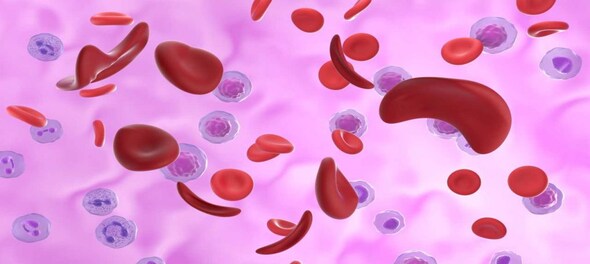
India has released new sickle cell anaemia guidelines aimed at enhancing the screening, awareness, and treatment of the disease. The guidelines, developed by the Indian Council of Medical Research (ICMR), emphasise the importance of early intervention and aggressive management of the disease.
The Standard Treatment Guidelines for Sickle Cell Anemia Disease were unveiled by Minister of State for Health and Family Welfare Bharati Pawar on May 8, 2023.
In the 2023-24 Union Budget, Finance Minister Nirmala Sitharaman had announced India's aim to eradicate sickle cell anaemia by 2047. Under a new scheme announced this February, the Centre plans to screen 70 million Indians in affected tribal areas under the age of 40 years.
Sickle cell anaemia is a genetic blood disorder characterised by the abnormal sickling of red blood cells under conditions of low oxygen levels or stress. According to the Ministry of Tribal Affairs, about one in 86 births among Scheduled Tribes have sickle cell disease.
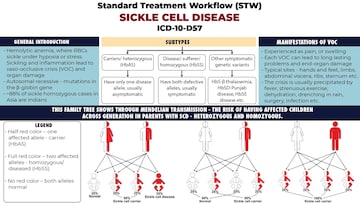 Image: Indian Council of Medical Research
Image: Indian Council of Medical ResearchThe new guidelines outline different subtypes of the disease, including carriers (heterozygous), individuals with the disease (homozygous) and other symptomatic genetic variants.
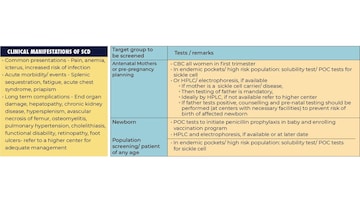 Image: Indian Council of Medical Research
Image: Indian Council of Medical ResearchThe manifestations of sickle cell disease include pain and anaemia, while its long-term complications can be much more serious and lead to problems such as end-organ damage and pulmonary hypertension.
Clinical manifestations of sickle cell disease
Screen target groups
To address the disease comprehensively, the guidelines recommend screening specific target groups. Antenatal mothers or those planning pregnancy should undergo comprehensive blood tests, including complete blood count (CBC), solubility tests or point-of-care tests for sickle cell anaemia.
Newborns should also be screened using point-of-care tests, and if available, high-performance liquid chromatography (HPLC) or electrophoresis can be conducted at a later stage.
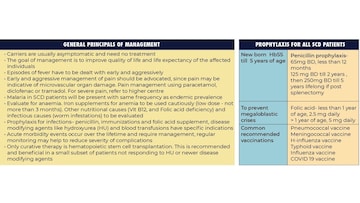 Image: Indian Council of Medical Research
Image: Indian Council of Medical ResearchPrevention of sickle cell disease
The guidelines highlight the importance of prophylaxis and management for sickle cell anaemia patients. Prophylaxis measures include penicillin, immunisations, folic acid supplementation, and vaccinations against diseases such as pneumococcal infection, meningococcal infection, H-influenza, typhoid, influenza, and COVID-19.
Hydroxyurea (HU) is recommended as a disease-modifying agent for patients above two years of age, with dose adjustments based on age and weight.
Treatment for sickle cell disease
The guidelines provide specific dosing instructions and caution against potential side effects. The only curative therapy for sickle cell anaemia is hematopoietic stem cell transplantation, which is recommended for a small subset of patients who do not respond to other treatment options.
The guidelines recommend prompt and effective pain management using medications such as paracetamol, diclofenac, or tramadol. Severe pain cases should be referred to higher centres for specialized care.
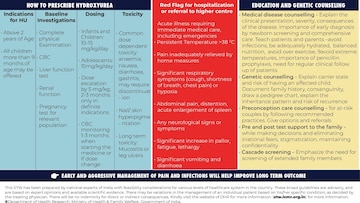 Image: Indian Council of Medical Research
Image: Indian Council of Medical ResearchEducation and genetic counselling
In addition to medical management, the guidelines emphasise education, genetic counseling and support for patients and their families. Patients and parents are educated about the disease, the importance of early diagnosis through newborn screening, and the need for regular clinical follow-ups.
Genetic counselling is provided to explain the carrier state, the risk of having an affected child, and the inheritance pattern. Preconception care counselling is recommended for at-risk couples.
The guidelines also underscore the significance of early and aggressive management of pain and infections to improve long-term outcomes for sickle cell anaemia patients. Early detection, comprehensive care, and appropriate support systems can make a significant difference in the lives of individuals affected by this chronic condition.
With the release of these new guidelines, India aims to strengthen its approach to managing sickle cell anaemia, ultimately improving the quality of life and life expectancy of affected individuals.
Check out our in-depth Market Coverage, Business News & get real-time Stock Market Updates on CNBC-TV18. Also, Watch our channels CNBC-TV18, CNBC Awaaz and CNBC Bajar Live on-the-go!


PM Modi's 'Apni Kashi' set for massive 5km, 4-hour-long road show on May 13
May 8, 2024 11:25 AM
In Andhra's Pithapuram, its Pawan Kalyan's charisma vs YSRCP MP Geetha's credentials
May 8, 2024 10:23 AM

